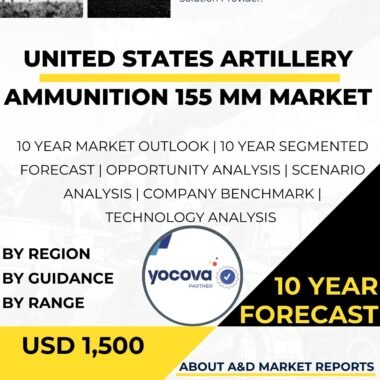Description
Japan Artillery Ammunition 155 mm Market
The Japan artillery ammunition 155 mm market has seen significant growth and strategic importance as the nation seeks to modernize its artillery capabilities and enhance its military readiness. 155mm artillery ammunition is a critical component of modern artillery systems, providing long-range firepower, precision, and versatility for ground-based operations.
The artillery ammunition market in Japan encompasses a wide range of 155mm munitions, including high-explosive (HE) rounds, illumination rounds, smoke rounds, and precision-guided munitions (PGMs). These munitions are utilized by the Japan Ground Self-Defense Force (JGSDF) to provide effective fire support, suppress enemy positions, and engage targets with precision accuracy.
One of the primary applications of 155mm artillery ammunition in Japan is in enhancing the JGSDF’s ability to deliver powerful and accurate firepower in support of ground operations. HE rounds are used to neutralize enemy positions, fortifications, and troop concentrations, providing infantry units with the necessary firepower to gain a tactical advantage on the battlefield.
Moreover, illumination rounds play a crucial role in enhancing situational awareness during nighttime operations. These rounds emit a bright light upon reaching the apex of their trajectory, illuminating the battlefield and providing critical visibility to friendly forces and intelligence gathering.
Furthermore, smoke rounds are used to create a visual barrier, obscuring enemy vision and facilitating troop movements, enabling friendly forces to maneuver safely and avoid detection.
As Japan emphasizes indigenous defense capabilities, the domestic production and development of 155mm artillery ammunition have seen substantial growth. Collaborations between the government and domestic defense industries have fostered innovation, leading to the creation of state-of-the-art munitions tailored to Japan’s specific operational requirements.
Japan’s alliance with the United States has also played a significant role in the development of its artillery ammunition capabilities. Through this partnership, Japan has access to advanced munition technologies, expertise, and support, contributing to the modernization of its defense forces and enhancing interoperability with allied forces.
The artillery ammunition market in Japan also benefits from advancements in munition technology, such as the development of precision-guided munitions. PGMs offer increased accuracy and reduced collateral damage, allowing the JGSDF to engage high-value targets with minimal risk to civilians and critical infrastructure.
However, the artillery ammunition market in Japan also faces challenges related to cost, technology integration, and interoperability. Developing and producing advanced artillery munitions can be expensive, requiring efficient resource allocation and long-term planning.
Moreover, ensuring seamless integration between different types of artillery ammunition and existing artillery systems requires careful consideration and testing to optimize their effectiveness on the battlefield.
Additionally, addressing environmental and safety considerations is essential for the responsible handling, storage, and disposal of artillery ammunition, ensuring that it adheres to international safety standards and regulations.
In conclusion, the Japan artillery ammunition 155mm market has witnessed significant growth and strategic importance, driven by the nation’s focus on modernizing its artillery capabilities and enhancing its military readiness. 155mm artillery ammunition provides critical solutions for delivering effective firepower, providing situational awareness, and supporting ground-based operations, catering to Japan’s specific defense requirements. The collaboration between the government and domestic defense industries, as well as international partnerships with allied nations, fosters innovation and contributes to the growth of the domestic artillery ammunition market. Addressing challenges related to cost, technology integration, interoperability, and environmental considerations is crucial for further enhancing Japan’s artillery ammunition capabilities and ensuring that its defense forces have access to advanced and reliable munitions to support military operations, enhance situational awareness, and contribute to the nation’s operational excellence and safety. With its strategic focus on indigenous defense capabilities and partnerships with allied nations, Japan remains committed to leveraging advanced artillery ammunition technologies to enhance its military capabilities, safeguard personnel, and contribute to regional and global peace and security.




